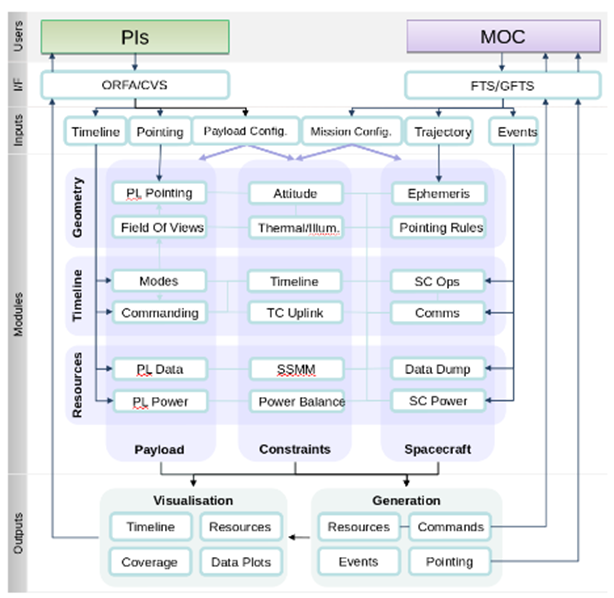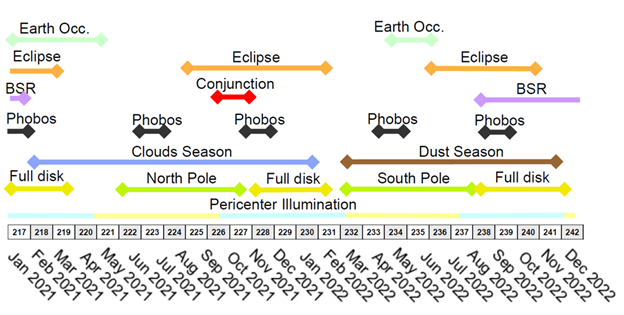Mars Express Science Ground Segment operations overview
- 1ESA European Space Astronomy Centre (ESAC), Camino bajo del Castillo s/n, Urb. Villafranca del Castillo, P.O. Box 78, 28691 Villanueva de la Cañada, Madrid, Spain
- 2European Space Research and Technology Centre (ESTEC), Keplerlaan 1, 2201 AZ Noordwijk ZH, Netherlands
Abstract
Mars Express experienced numerous challenges from initial operations to date. We present the last scientific operations performed by the Science Ground Segment (SGS) as well as last modifications in the planning processes and software systems to deal with the spacecraft degradation and the operational changes.
1. Introduction
Mars Express remains one of ESA’s most scientifically productive missions and has fully accomplished its mission objectives. The mission provides a unique platform for Mars climate evolution research to help understand the complex atmospheric processes present on Mars. It uniquely covers a huge range of different observations from the subsurface and surface to the magnetosphere and moons.
The Mars Express (MEX) Science Ground Segment team is responsible for the definition and maintenance of the overall scientific plan in cooperation with the Project Scientist (PS). The overview of the SGS system is shown in figure 1.

Figure 1: SGS system based on the mission planning
Some of the team duties are:
- Coordinating the candidate observation selection process between the Instrument Teams and the relevant Mission Operation Centre (MOC) teams, supporting the planning activities of the MEX Principal Investigators (PI) in the preparation of science operations for their instruments and shielding MOC from the details of this iterative process,
- Producing a set of consolidated instrument payload operations requests and pointing timeline requests based on the Long Term Plan (LTP) and tool structure. the output of the Medium Term Planning (MTP) exercise, and transferring these to MOC. Specifying the commanding though the short term planning (STP),
- Iterating the instrument payload operation requests with the MOC and the PIs to resolve inconsistencies,
2. Recent changes in science operations
After operating for 18 years, through changing Martian seasons and changes in the condition of the spacecraft, planning the science operations of the mission continues to be a challenge. We will present the improvements over the last few years of our operating methodologies, instrument operation changes, software improvements and scientific observation modifications; degradation of spacecraft systems, overcoming major uncertainty in battery capacity and eclipse operations, expansion of compatible ground relays to adjust to a reduction in antenna time due to increases in spacecrafts at Mars…
Versatility in SGS is the key to success, as there are continuous changes in the Martian seasons, data volume, illumination conditions, power during eclipses and many other factors.

Figure 2: Mission scheme as a function of the Martian climate.
3. Future of the mission and system improvements
Finally, we will summarize the future objectives for the long-term planning period up to 2025 and the general status of the spacecraft and instruments. All these are aligned with the changing Martian seasons as represented in figure 2. Among these activities are:
- Continue the observations of all instruments to fulfill the scientific objectives of the mission extension and new scientific challenges,
- Continuing mutual science observations with the Trace Gas Orbiter (TGO), providing scientific context to the new observations,
- Updates of the ground segment to ensure the extended lifetime of the mission with new operational constraints,
- Support the communications with surface assets (USA and China) and characterize landing sites for future robotic missions.
- Providing unique information about Phobos surface imagery and spectra
4. Summary and Conclusions
Flexibility is key for science missions, and it requires a qualified science operations team with both engineering and scientific experience to achieve their goals. In order to improve SGS planning systems for planetary missions it is vital to take advantage of long-term missions such as MEX in order to transfer the planning knowledge and experience to more complex objectives of the future.
Acknowledgements
The members of the Science Ground Segment team are particularly grateful for the assistance provided by the Flight Control Team at the MOC and the collaboration of all the instrument teams. Without their excellent and constant collaboration in the science planning process, the Mars Express mission would not have obtained such prolific scientific results.
How to cite: Marín-Yaseli de la Parra, J., Cardesín-Moinelo, A., Merritt, D., Sierra Burgos, M., Esquej, P., Grotheer, E., Breitfellner, M., Muñiz, C., Escalante, A., Martin, P., Titov, D., and Wilson, C.: Mars Express Science Ground Segment operations overview, Europlanet Science Congress 2022, Granada, Spain, 18–23 Sep 2022, EPSC2022-752, https://doi.org/10.5194/epsc2022-752, 2022.

